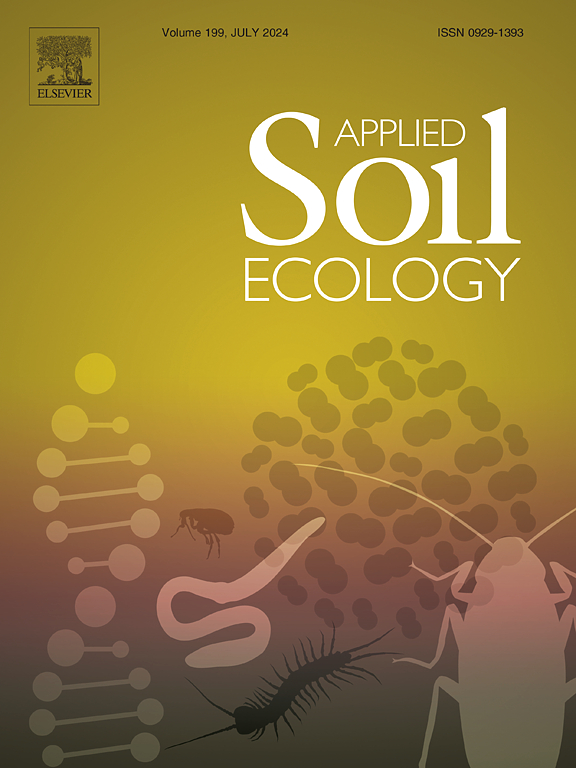丛枝菌根真菌通过不同植被生态系统中微生物的相互作用调节土壤微生物网络的复杂性
IF 5
2区 农林科学
Q1 SOIL SCIENCE
引用次数: 0
摘要
丛枝菌根真菌(AMF)与多种植物根系建立了共生伙伴关系,深刻地塑造了土壤微生物群落结构。然而,控制AMF对微生物相互作用影响的复杂机制仍不清楚。本研究旨在探讨芦雅山不同生态系统(草、灌木和森林)中AMF群落的聚集动态及其对多域土壤微生物网络结构的影响。不同植被类型的真菌群落多样性、组成和微生物网络结构存在显著差异。结果表明,微生物网络中AMF的加入大大简化了灌木和森林生态系统中微生物网络的复杂性。AMF群落内的随机过程增加了微生物网络的复杂性。值得注意的是,AMF增强了土壤微生物网络的稳健性,同时降低了它们的脆弱性,强调了它们在提高网络稳定性方面的作用。此外,AMF的加入改变了土壤多域网络的组成,减少了关键分类群的数量,间接促进了原生动物和线虫介导的营养级联反应,从而调节了土壤多域网络的复杂性。AMF对细菌网络结构的影响显著大于对其他微生物网络结构的影响。综上所述,这些发现为AMF群落影响土壤微生物网络的机制提供了重要见解,同时为生态系统管理和恢复实践提供了科学基础。本文章由计算机程序翻译,如有差异,请以英文原文为准。

Arbuscular mycorrhizal fungi modulate soil microbial network complexity via microbial interactions in different vegetation ecosystems
Arbuscular mycorrhizal fungi (AMF) establish symbiotic partnerships with diverse plant roots, profoundly shaping the structure of soil microbial communities. However, the complex mechanisms governing the influence of AMF on microbial interactions remain unclear. The aim of this research was to elucidate the dynamics of AMF community assembly across distinct ecosystems (grass, shrub, and forest) on Luya Mountain and the related implications for multidomain soil microbial network structures. AMF community diversity, composition, and microbial network structure varied significantly among the vegetation types. The results revealed that the inclusion of AMF in microbial networks substantially simplified network complexity in shrub and forest ecosystems. Stochastic processes within the AMF community increased the complexity of the microbial networks. Notably, AMF enhanced the robustness of soil microbial networks while reducing their vulnerability, underscoring their role in increasing network stability. Moreover, the inclusion of AMF in the networks altered the composition and reduced the quantity of keystone taxa, indirectly fostering trophic cascades mediated by protozoa and nematodes, thereby modulating the complexity of the soil multidomain networks. The impact of AMF on bacterial network structure was significantly greater than that on other microbial network structures. Taken together, these findings provide critical insights into the mechanisms through which AMF communities influence soil microbial networks while offering a scientific foundation for ecosystem management and restoration practices.
求助全文
通过发布文献求助,成功后即可免费获取论文全文。
去求助
来源期刊

Applied Soil Ecology
农林科学-土壤科学
CiteScore
9.70
自引率
4.20%
发文量
363
审稿时长
5.3 months
期刊介绍:
Applied Soil Ecology addresses the role of soil organisms and their interactions in relation to: sustainability and productivity, nutrient cycling and other soil processes, the maintenance of soil functions, the impact of human activities on soil ecosystems and bio(techno)logical control of soil-inhabiting pests, diseases and weeds.
 求助内容:
求助内容: 应助结果提醒方式:
应助结果提醒方式:


